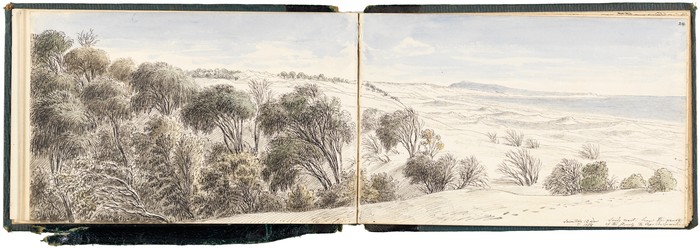
Sandy Coast from the mouth of the Glenelg to Cape Bridgewater
1857
Pencil, pen and wash on paper
Purchased from the Clune Galleries
DGB 16 vol 7
Pencil, pen and wash on paper
Purchased from the Clune Galleries
DGB 16 vol 7
Eugene von Guérard’s strict formal art training in Europe in the 1830s and 1840s honed his drawing skills: he was an excellent and prolific sketcher, filling 46 sketchbooks with exquisite details of his extensive travels throughout Europe and Australia. Attracted by the gold rushes, von Guérard arrived in Victoria in 1852 but soon found that his art in fact earned him more. He quickly became one of the leading landscape artists of mid-19th century Australia, and these days his major oil paintings will fetch millions of dollars in the art market.
Von Guérard sketchbooks were one of the primary tools of his trade; once back in his art studio and in front of a canvas, he incorporated their detail into his oil paintings, using his sketchbooks as someone today might use a camera. His sketches varied from quick outlines of landforms and landscapes to patiently composed, highly finished and coloured drawings.
A feature of von Guérard’s oil paintings was their focus on the particular geological formation of a landscape and its vegetation: he believed that in recording the specific detail of an area he was celebrating the power and majesty of God. He travelled widely throughout southeastern Australia in search of subject matter, and he would often write about day-to-day events in these sketchbooks. This sketch was made on an expedition he took to South Australia in December 1857.


 Back to list
Back to list